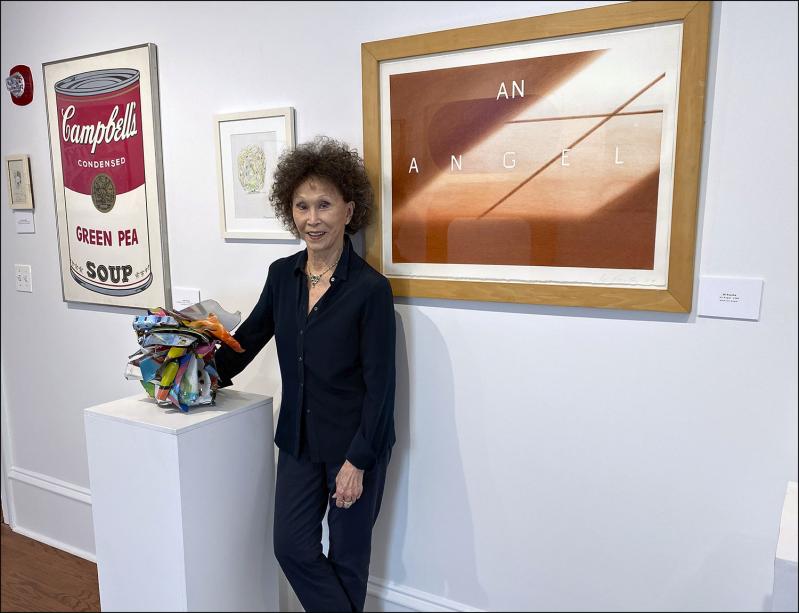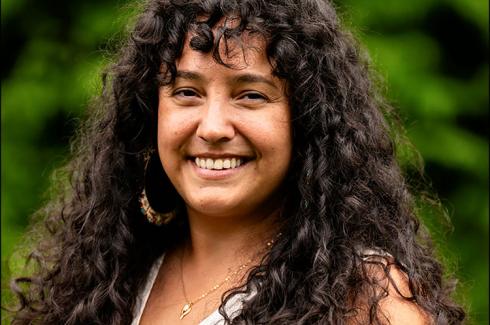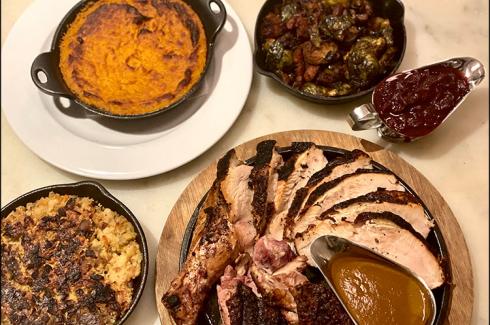If you see one art exhibition this weekend, it should be “Echoes & Nostalgia,” a show of some 100 remarkable artworks from the collection of Lana Jokel, a renowned documentary filmmaker whose body of work includes 18 films about contemporary art and artists.
It’s not an exaggeration to say the quality and diversity of her holdings — and these represent less than half of her collection — are astounding. The show, at the Bridgehampton Museum’s Nathaniel Rogers House, includes work by Ed Ruscha, Andy Warhol, Roy Lichtenstein, Claes Oldenburg, Larry Rivers, Elizabeth Strong-Cuevas, Robert Motherwell, Keith Sonnier, Willem de Kooning, and John Chamberlain. But there are many arresting works by less well-known artists, and even a few pieces for which the artist is unknown.
Because it’s all about Ms. Jokel’s personal taste and her relationships. As she said during a tour of the show, “Every one of these artworks has a story.”
Warhol is the first story. After learning the art of editing film, she co-edited “Heat” (1972), which was produced by Warhol and directed by Paul Morrissey. As partial payment, Warhol gave her work from his “Flowers” series. That launched her collection.
“Then he also gave me this as a present,” she said, pointing to “Green Pea,” a screenprint of one of his Campbell’s Soup cans. “I told him I hate green peas.” But it has pride of place in the show.
One wall of the show features four works by Jasper Johns, who is a very close friend. Because he knew she loved Paris, he sent her an ink and pencil drawing he made in Paris of the number four. Beneath the image it says “4LANA.” He subsequently gave her an etching of the number zero.
“At one point I told him I wanted to buy a little something from him.” She requested the number two, of which he made a monoprint. Lined up on the gallery wall they read “2 4 0.” “I called him up and said, guess what, these numbers are very special because they represent February 1940, which is my Chinese calendar birthday.”

As she said of her collection, “It’s very personal.” It includes many works by Sven Lukin, an artist with whom she had a serious relationship on and off for 40 years. Lukin was a venturesome artist whose work ranged from large shaped canvases to a heart-shaped wing made from canvas on board with string to a potato painting. “I’m happy we had all those years together,” she said.
In fact, her show came about when the artist Mark Wilson was organizing “I Say Potato,” which was at the museum in June. Mr. Wilson came to her studio and picked one of Lukin’s potato paintings. “He was going to the museum with it, and I said I want to see the space.” While there she met Tim Malyk, the collections manager, and told him she thought the museum would be the perfect place to show her collection. The rest is . . . well . . . it’s on the walls.
The show also includes a number of works by Ed Ruscha, an artist from California she met in 1984 when he was having a show at Leo Castelli Gallery. Their connection began with her approaching him about a project involving artist-made screens that already had Roy Lichtenstein involved.
After he agreed to participate, he sent her a letter asking for a date to go to the Museum of Modern Art. “I answered back saying if you get me back before the chariot turns into a pumpkin, then yes.” They were together for about two years, during which they traveled back and forth between Los Angeles and New York, as well as abroad.
The show includes a portrait Mr. Ruscha made of Ms. Jokel when they were in Paris. Consisting of a ruler, lead, and metal, it is a facial profile. “We had a very special relationship, and today we still talk to each other,” she said. “All of his works were presents from him over the years.”
His is not the only portrait of Ms. Jokel in the exhibition. There is a charcoal and ink portrait from the 1970s by Larry Rivers. In the lower right corner it says, “For Ping,” and one of her eyeballs has the word “Ping” instead of a pupil.
Her Chinese name is Tse Ping, which means “wisdom” and “apple.” When she showed it to Eric Fischl at the opening, he said, “I can see why he put the ping there. When he saw you, he went ping!” Among the other works dedicated to Ms. Jokel, either as Tse Ping or Lana, are by Motherwell, Jack Youngerman, Lichtenstein, James Nares, and de Kooning.
The many other arresting pieces in the exhibition include a recent painting by Brian O’Leary, two large photocollages by Peter Beard, and two remarkable works by Sara Friedlander that feature photographs she took in China of the last women with bound feet, superimposed on her paintings. In a large painting by Paton Miller, the eyes of the subject at its center seem to follow the viewer.
Alice Hope, the subject of Ms. Jokel’s most recent documentary, is represented by a wall piece made of powder-coated chains and door screen. Also of note are two striking C-prints by Ken Botto that are staged tableaus of toys and found objects, and a five-panel painting of a nude woman from 1948 by Rene Magritte.
“I buy works because I really love them, because they speak to me in some way,” she said. Thus, a beautiful antique birdcage, and a sculpture by Anthony Caro that looks like steel but is in fact made from cardboard.
Ms. Jokel has never shown her collection before. The impetus was in part that in June 2024, thanks to the efforts of Rachel Stella, who lives in Paris and is the daughter of Frank Stella and Barbara Rose, Ms. Jokel’s film archive was acquired by the Centre Pompidou, Musée National d’Art Moderne in Paris. “I was so thrilled. Then I started thinking, what am I doing to do with my art collection. Hardly anybody has seen it and they are my babies. So when I saw this museum I thought it was the perfect place.”
The exhibition will continue through Sept. 21.




